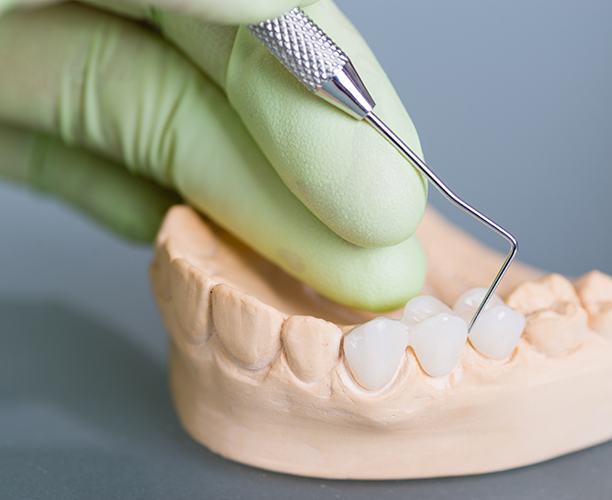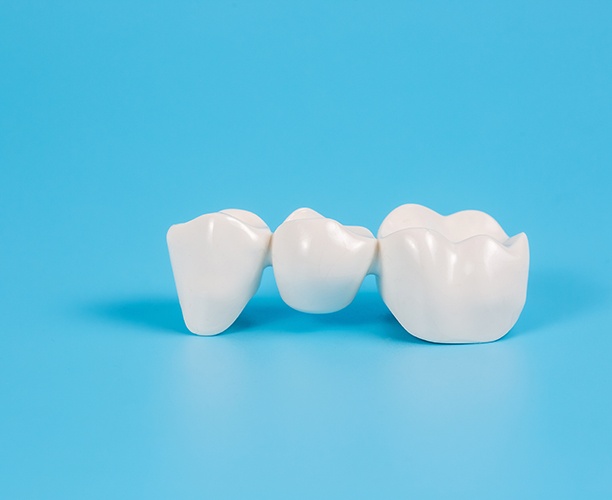


Whether you’ve lost one tooth or several, gaps in your grin can greatly detract from your daily quality of life. Not only is it much harder to chew your food sufficiently or enunciate words clearly, but you might also feel so anxious about the changes in your reflection that you avoid spending time with others.
Fortunately, your Painted Skies Dental Center team offers a versatile solution for multiple missing teeth with customized dental bridges that restore your smile’s appearance and functionality. Continue reading to learn more about these prosthetics, and feel free to contact us for additional information.

Dental bridges are replacement teeth that are typically made from resilient ceramic or resin. These prosthetics contain the necessary number of pontics to replace one or multiple teeth in a row to refurbish your grin. They also include a dental crown at each end that is designed to attach to the teeth on both sides of the wide space in your smile. Our team will take the time to customize your restoration to match your natural teeth, so it’s almost impossible to tell the difference once it’s bonded in place.

Although potentially anyone with missing teeth can benefit from a dental bridge, that doesn’t mean it’s the best solution for everyone’s unique circumstances. Before proceeding, you must consult with one of our experts to determine if you’re a good candidate. Then, based on the results of your examination and your current dental condition, we might recommend one of the following options to close the gap in your grin:
This is the standard method and is ideal for restoring one to three missing teeth. The dental crowns on each side of this prosthetic are designed to fit over healthy teeth on both ends of the space in your smile. If yours are damaged or decayed, they can’t provide a strong enough foundation, and we might suggest an implant bridge instead.
These are very similar to traditional bridges in their design and creation, but instead of attaching to abutment teeth, they will cap strategically placed dental implants that are embedded directly into your jawbone. This requires that you have sufficient bone density to carry the weight of your bridge. If yours is too thin, sometimes a bone graft can bulk it up enough to proceed.

The longer you wait to restore your lost teeth, the more likely your remaining ones are to shift out of alignment. Unfortunately, this wears down your enamel, increasing your vulnerability to decay and disease. Thankfully, there are many benefits to restoring your grin with a dental bridge, including:
There are several factors that impact the longevity of your dental bridges, including the material that is used. That said, they typically last upwards of 15 years with proper care. The key to keeping yours in pristine condition is committing to good habits, like brushing twice a day and coming to our office twice a year for a checkup and cleaning. Of course, it’s equally as important that you avoid habits that have the potential to damage your dental bridge (or your smile in general), including smoking and using your teeth as tools to open things.
Typically, dental bridges are used to replace between one and four missing teeth. Any more than that, and the stability of your restoration may be compromised. Fortunately, if you aren’t a candidate for dental bridges, we can explore the other tooth-replacement solutions available, like modern dentures and state-of-the-art dental implants.
Dental bridges, like your natural teeth, aren’t indestructible. That’s why we encourage our patients to exercise caution with foods that have the potential to chip, crack, or fracture their restoration, like hard pretzels, tortilla chips, and peanut brittle. Additionally, sugary and starchy foods should be kept to a minimum, and sticky snacks, like fruit gummies and caramel, should be avoided entirely.
Dental bridges don’t just feel natural; they look natural. That’s because they are crafted from lifelike materials, like dental porcelain. Plus, they are custom-made to suit your face shape and blend in seamlessly with your surrounding teeth. In short, you don’t have to worry – no unwanted attention will be drawn to your smile moving forward.
Since dental bridges are artificial, they cannot get cavities. However, that doesn’t mean that you no longer have to brush and floss. Quite the opposite: since any remaining teeth you have can still decay and your gums can develop an infection if they are neglected, you need to commit to good oral hygiene habits like flossing every night before bed, using an ADA-approved mouthwash, and brushing for two minutes each morning and evening.
Good news: dental bridges are typically partially covered by dental insurance! That said, there may be restrictions on your plan, like waiting periods or annual maximums. If you need any help understanding your benefits, you’re more than welcome to ask us for help. We’re proud to be in-network with several popular providers, including Cigna, and we have the experience and knowledge needed to make maximizing your coverage stress-free instead of stressful.